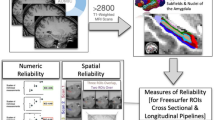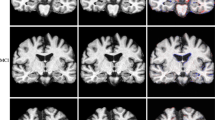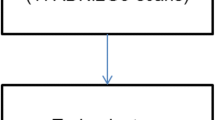Abstract
It is important to have accurate estimates of normal age-related brain structure changes and to understand how the choice of measurement technique may bias those estimates. We compared longitudinal change in hippocampal volume, laterality and atrophy measured by manual tracing and FreeSurfer (version 5.3) in middle age (n = 244, 47.2[1.4] years) and older age (n = 199, 67.0[1.4] years) individuals over 8 years. The proportion of overlap (Dice coefficient) between the segmented hippocampi was calculated and we hypothesised that the proportion of overlap would be higher for older individuals as a consequence of higher atrophy. Hippocampal volumes produced by FreeSurfer were larger than manually traced volumes. Both methods produced a left less than right volume laterality difference. Over time this laterality difference increased for manual tracing and decreased for FreeSurfer leading to laterality differences in left and right estimated atrophy rates. The overlap proportion between methods was not significantly different for older individuals, but was greater for the right hippocampus. Estimated middle age annualised atrophy rates were − 0.39(1.0) left, 0.07(1.01) right, − 0.17(0.88) total for manual tracing and − 0.15(0.69) left, − 0.20(0.63) right, − 0.18(0.57) total for FreeSurfer. Older age atrophy rates were − 0.43(1.32) left, − 0.15(1.41) right, − 0.30 (1.23) total for manual tracing and − 0.34(0.79) left, − 0.68(0.78) right, − 0.51(0.65) total for FreeSurfer. FreeSurfer reliably segments the hippocampus producing atrophy rates that are comparable to manual tracing with some biases that need to be considered in study design. FreeSurfer is suited for use in large longitudinal studies where it is not cost effective to use manual tracing.



Similar content being viewed by others

References
Anstey KJ et al (2012) Cohort profile: the PATH through life project. Int J Epidemiol 41:951–960. https://doi.org/10.1093/ije/dyr025
Arnold SJ et al (2015) Hippocampal volume is reduced in schizophrenia and schizoaffective disorder but not in psychotic bipolar I disorder demonstrated by both manual tracing and automated parcellation (FreeSurfer). Schizophr Bull 41:233–249. https://doi.org/10.1093/schbul/sbu009
Barnes J et al (2004) Differentiating AD from aging using semiautomated measurement of hippocampal atrophy rates Neuroimage https://doi.org/10.1016/j.neuroimage.2004.06.028
Barnes J et al (2008) A comparison of methods for the automated calculation of volumes and atrophy rates in the hippocampus NeuroImage 40:1655–1671 https://doi.org/10.1016/j.neuroimage.2008.01.012
Barnes J et al (2009a) A meta-analysis of hippocampal atrophy rates in Alzheimer’s disease. Neurobiol Aging 30:1711–1723. https://doi.org/10.1016/j.neurobiolaging.2008.01.010
Barnes J, Ourselin S, Fox NC (2009b) Clinical application of measurement of hippocampal atrophy in degenerative dementias. Hippocampus 19:510–516. https://doi.org/10.1002/hipo.20617
Bergouignan L et al (2008) Can voxel based morphometry, manual segmentation and automated segmentation equally detect hippocampal volume differences in acute depression? Neuroimage 45:29–37. https://doi.org/10.1016/j.neuroimage.2008.11.006
Bland JM, Altman DG (1999) Measuring agreement in method comparison studies Stat Methods Med Res 8:135–160
Boccardi M et al (2011) Survey of protocols for the manual segmentation of the Hippocampus: preparatory steps towards a joint EADC-ADNI harmonized protocol. J Alzheimer’s Dis 26:61–75. https://doi.org/10.3233/JAD-2011-0004
Boccardi M et al (2015) Delphi definition of the EADC-ADNI harmonized protocol for hippocampal segmentation on magnetic resonance. Alzheimer’s Dement 11:126–138. https://doi.org/10.1016/j.jalz.2014.02.009
Braak H, Braak E, Bohl J, Reintjes R (1996) Age, neurofibrillary changes, A beta-amyloid and the onset of Alzheimer’s disease. Neurosci Lett 210:87–90
Buckner RL, Head D, Parker J, Fotenos AF, Marcus D, Morris JC, Snyder AZ (2004) A unified approach for morphometric and functional data analysis in young, old, and demented adults using automated atlas-based head size normalization: reliability and validation against manual measurement of total intracranial volume. Neuroimage 23:724–738. https://doi.org/10.1016/j.neuroimage.2004.06.018
Button KS, Ioannidis JP, Mokrysz C, Nosek BA, Flint J, Robinson ES, Munafò MR (2013) Power failure: why small sample size undermines the reliability of neuroscience. Nat Rev Neurosci 14:365–376. https://doi.org/10.1038/nrn3475
Carstensen B (2010) Comparing methods of measurement: extending the LoA by regression. Stat Med 29:401–410. https://doi.org/10.1002/sim.3769
Cash DM et al (2015) Assessing atrophy measurement techniques in dementia: results from the MIRIAD atrophy challenge NeuroImage 123:149–164 https://doi.org/10.1016/j.neuroimage.2015.07.087
Cherbuin N, Anstey KJ, Réglade-Meslin C, Sachdev PS (2009) In vivo hippocampal measurement and memory: a comparison of manual tracing and automated segmentation in a large community-based sample PLoS ONE https://doi.org/10.1371/journal.pone.0005265
Cherbuin N, Sargent-Cox K, Easteal S, Sachdev P, Anstey KJ (2014) Hippocampal atrophy is associated with subjective memory decline: the PATH through life study. Am J Geriatr Psychiatry 23(5):446–455
de Flores R et al (2014) Effects of age and Alzheimer’s disease on hippocampal subfields: comparison between manual and freesurfer volumetry. Hum Brain Mapp https://doi.org/10.1002/hbm.22640
Dice LR (1945) Measures of the amount of ecologic association between species. Ecology 26:297–302. https://doi.org/10.2307/1932409
Dill V, Franco AR, Pinho MSS (2015) Automated methods for hippocampus segmentation: the evolution and a review of the state of the art. Neuroinformatics 13:133–150. https://doi.org/10.1007/s12021-014-9243-4
Doring TM, Kubo TT, Cruz LC Jr, Juruena MF, Fainberg J, Domingues RC, Gasparetto EL (2011) Evaluation of hippocampal volume based on MR imaging in patients with bipolar affective disorder applying manual and automatic segmentation techniques. J Magn Reson Imaging 33:565–572. https://doi.org/10.1002/jmri.22473
Draganski B, Gaser C, Kempermann G (2006) Temporal and spatial dynamics of brain structure changes during extensive learning. J Neurosci https://doi.org/10.1523/JNEUROSCI.4628-05.2006
Erickson KI et al (2011) Exercise training increases size of hippocampus and improves memory. Proc Natl Acad Sci USA 108:3017–3022. https://doi.org/10.1073/pnas.1015950108
Fischl B et al (2002) Whole brain segmentation: automated labeling of neuroanatomical structures in the human brain. Neuron 33:341–355. https://doi.org/10.1016/S0896-6273(02)00569-X
Fischl B et al (2004) Automatically parcellating the human cerebral cortex. Cereb Cortex 14:11–22. https://doi.org/10.1093/cercor/bhg087
Fjell AM et al (2013) Critical ages in the life course of the adult brain: nonlinear subcortical aging. Neurobiol Aging 34:2239–2247. https://doi.org/10.1016/j.neurobiolaging.2013.04.006
Fraser MA, Shaw ME, Cherbuin N (2015) A systematic review and meta-analysis of longitudinal hippocampal atrophy in healthy human ageing. Neuroimage https://doi.org/10.1016/j.neuroimage.2015.03.035
Frisoni GB, Fox NC, Jack CR, Scheltens P, Thompson PM (2010) The clinical use of structural MRI in Alzheimer disease. Nat Rev Neurol 6:67–77
Frisoni GB et al (2015) The EADC-ADNI Harmonized Protocol for manual hippocampal segmentation on magnetic resonance: evidence of validity. Alzheimer’s Dementia 11:111–125. https://doi.org/10.1016/j.jalz.2014.05.1756
Gronenschild EHBM, Habets P, Jacobs HIL, Mengelers R, Rozendaal N, van Os J, Marcelis M (2012) The effects of freesurfer version, workstation type, and macintosh operating system version on anatomical volume and cortical thickness measurements. PLoS ONE https://doi.org/10.1371/journal.pone.0038234
Hsu YY, Schuff N, Du AT, Mark K, Zhu X, Hardin D, Weiner MW (2002) Comparison of automated and manual MRI volumetry of hippocampus in normal aging and dementia. J Magn Reson Imaging 16:305–310. https://doi.org/10.1002/jmri.10163
Jinno S (2015) Aging affects new cell production in the adult hippocampus: a quantitative anatomic review. J chem Neuroanat https://doi.org/10.1016/j.jchemneu.2015.10.009
Leung KK et al (2010) Automated cross-sectional and longitudinal hippocampal volume measurement in mild cognitive impairment and Alzheimer’s disease. Neuroimage 51:1345–1359. https://doi.org/10.1016/j.neuroimage.2010.03.018
Makris N et al (2004) General brain segmentation: method and utilization Massachusetts General Hospital Boston, MA, USA
Maller JJ, Réglade-Meslin C, Anstey KJ, Sachdev P (2006) Sex and symmetry differences in hippocampal volumetrics: before and beyond the opening of the crus of the fornix. Hippocampus 16:80–90. https://doi.org/10.1002/hipo.20133
Maller JJ et al (2011) Hippocampal sulcal cavities: prevalence, risk factors and relationship to memory impairment. Brain Res 1368:222–230. https://doi.org/10.1016/j.brainres.2010.10.089
Maltbie E et al (2012) Asymmetric bias in user guided segmentations of. brain structures Neuroimage 59:1315–1323. https://doi.org/10.1016/j.neuroimage.2011.08.025
Morey RA et al (2008) A comparison of automated segmentation and manual tracing for quantifying hippocampal and amygdala volumes Neuroimage 45:855–866. https://doi.org/10.1016/j.neuroimage.2008.12.033
Mulder ER et al (2014) Hippocampal volume change measurement: quantitative assessment of the reproducibility of expert manual outlining and the automated methods FreeSurfer and FIRST. Neuroimage 92:169–181. https://doi.org/10.1016/j.neuroimage.2014.01.058
Pfefferbaum A, Sullivan EV (2015) Cross-sectional versus longitudinal estimates of age-related changes in the adult brain: overlaps and discrepancies. Neurobiol Aging 36:2563–2567. https://doi.org/10.1016/j.neurobiolaging.2015.05.005
Raz N, Ghisletta P, Rodrigue KM, Kennedy KM, Lindenberger U (2010) Trajectories of brain aging in middle-aged and older adults: regional and individual differences. Neuroimage 51:501–511. https://doi.org/10.1016/j.neuroimage.2010.03.020
Reuter M, Schmansky NJ, Rosas DH, Fischl B (2012) Within-subject template estimation for unbiased longitudinal image analysis. Neuroimage 61:1402–1418. https://doi.org/10.1016/j.neuroimage.2012.02.084
Rogers BP, Sheffield JM, Luksik AS, Heckers S (2012) Systematic error in Hippocampal volume asymmetry measurement is minimal with a manual segmentation protocol. Front Neurosci 6:179. https://doi.org/10.3389/fnins.2012.00179
Sabuncu MR, Yeo TBT, Leemput VK, Fischl B, Golland P (2010) A generative model for image segmentation based on label fusion. IEEE Trans Med Imaging 29:1714–1729. https://doi.org/10.1109/tmi.2010.2050897
Sánchez-Benavides G, Gómez-Ansón B, Sainz A, Vives Y, Delfino M, Peña-Casanova J (2010) Manual validation of FreeSurfer’s automated hippocampal segmentation in normal aging, mild cognitive impairment, and Alzheimer disease subjects. Psychiatry Res 181:219–225. https://doi.org/10.1016/j.pscychresns.2009.10.011
Scahill RI, Frost C, Jenkins R, Whitwell JL, Rossor MN, Fox NC (2003) A longitudinal study of brain volume changes in normal aging using serial registered magnetic resonance imaging. Arch Neurol 60:989–994. https://doi.org/10.1001/archneur.60.7.989
Schmidt MF, Storrs JM, Freeman KB, Jack CR, Turner ST, Griswold ME, Mosley TH (2018) A comparison of manual tracing and FreeSurfer for estimating hippocampal volume over the adult lifespan. Hum Brain Mapp https://doi.org/10.1002/hbm.24017
Shaw ME, Abhayaratna WP, Sachdev PS, Anstey KJ, Cherbuin N (2016a) Cortical thinning at midlife: the PATH through life study. Brain Topogr 29:875–884. https://doi.org/10.1007/s10548-016-0509-z
Shaw ME, Sachdev PS, Anstey KJ, Cherbuin N (2016b) Age-related cortical thinning in cognitively healthy individuals in their 60s: the PATH through life study. Neurobiol Aging 39:202–209. https://doi.org/10.1016/j.neurobiolaging.2015.12.009
Shaw ME, Nettersheim J, Sachdev PS, Anstey KJ, Cherbuin N (2017) Higher fasting plasma glucose is associated with increased cortical thinning over 12 years: the PATH through life study. Brain Topogr 30:408–416. https://doi.org/10.1007/s10548-017-0544-4
Shen L et al (2010) Comparison of manual and automated determination of Hippocampal volumes in MCI and early AD. Brain Imaging Behav 4:86–95. https://doi.org/10.1007/s11682-010-9088-x
Shi F, Liu B, Zhou Y, Yu C, Jiang T (2009) Hippocampal volume and asymmetry in mild cognitive impairment and Alzheimer’s disease: Meta-analyses of MRI studies Hippocampus 19:1055–1064. https://doi.org/10.1002/hipo.20573
Sled JG, Zijdenbos AP, Evans AC (1998) A nonparametric method for automatic correction of intensity nonuniformity in MRI data. IEEE Trans Med Imaging 17:87–97. https://doi.org/10.1109/42.668698
Tae W, Kim S, Lee K, Nam E-C, Kim K (2008) Validation of hippocampal volumes measured using a manual method and two automated methods (FreeSurfer and IBASPM) in chronic major depressive disorder Neuroradiology 50:569–581. https://doi.org/10.1007/s00234-008-0383-9
Walsh EI, Shaw M, Sachdev P, Anstey KJ, Cherbuin N (2017) Brain atrophy in ageing: Estimating effects of blood glucose levels vs. other type 2 diabetes effects. Diabetes Metab https://doi.org/10.1016/j.diabet.2017.06.004
Watson C, Jack CR, Cendes F (1997) Volumetric magnetic resonance imaging. Clinical applications and contributions to the understanding of temporal lobe epilepsy. Arch Neurol 54:1521–1531
Wenger E et al (2014) Comparing manual and automatic segmentation of hippocampal volumes: Reliability and validity issues in younger and older brains. Hum Brain Mapp 35:4236–4248. https://doi.org/10.1002/hbm.22473
Woollett K, Maguire EA (2011) Acquiring “the Knowledge” of London’s layout drives structural brain changes. Curr Biol 21(24):2109–2114
Acknowledgements
The authors are grateful to Chantal Réglade-Meslin, Jerome Maller, Peter Butterworth, Simon Easteal, Helen Christensen, Patricia Jacomb, Karen Maxwell, and the PATH interviewers. The study was supported by an Australian Government Research Training Program (RTP) Scholarship, National Health and Medical Research Council (NHMRC) Grant Nos. 973302, 179805,350833 157125, and Australian Research Council (ARC) Grant No. 130101705. Kaarin Anstey was funded by NHMRC Fellowship No.1002560. This research was partly undertaken on the National Computational Infrastructure (NCI) facility in Canberra, Australia, which is supported by the Australian Commonwealth Government. The authors declare no competing financial interests. This research is supported by an Australian Government Research Training Program (RTP) Scholarship. This study is NOT industry sponsored.
Author information
Authors and Affiliations
Contributions
MAF contributed to the design of the study, conducted all statistical analyses, and managed all aspects of manuscript preparation and submission. MES contributed to the design of the study and the statistical analyses, provided methodological input and theoretical expertise, and contributed to writing and editing of the manuscript. KJA contributed to the design of the study, provided methodological input and theoretical expertise, and contributed to writing and editing of the manuscript. NC contributed to the design of the study and the statistical analyses, provided methodological input and theoretical expertise, and contributed to writing and editing of the manuscript.
Corresponding author
Ethics declarations
Conflict of interest
The authors have reported no conflicts of interest.
Additional information
Handling editor: Andrew Zalesky.
Electronic supplementary material
Below is the link to the electronic supplementary material.
Rights and permissions
About this article
Cite this article
Fraser, M.A., Shaw, M.E., Anstey, K.J. et al. Longitudinal Assessment of Hippocampal Atrophy in Midlife and Early Old Age: Contrasting Manual Tracing and Semi-automated Segmentation (FreeSurfer). Brain Topogr 31, 949–962 (2018). https://doi.org/10.1007/s10548-018-0659-2
Received:
Accepted:
Published:
Issue Date:
DOI: https://doi.org/10.1007/s10548-018-0659-2



